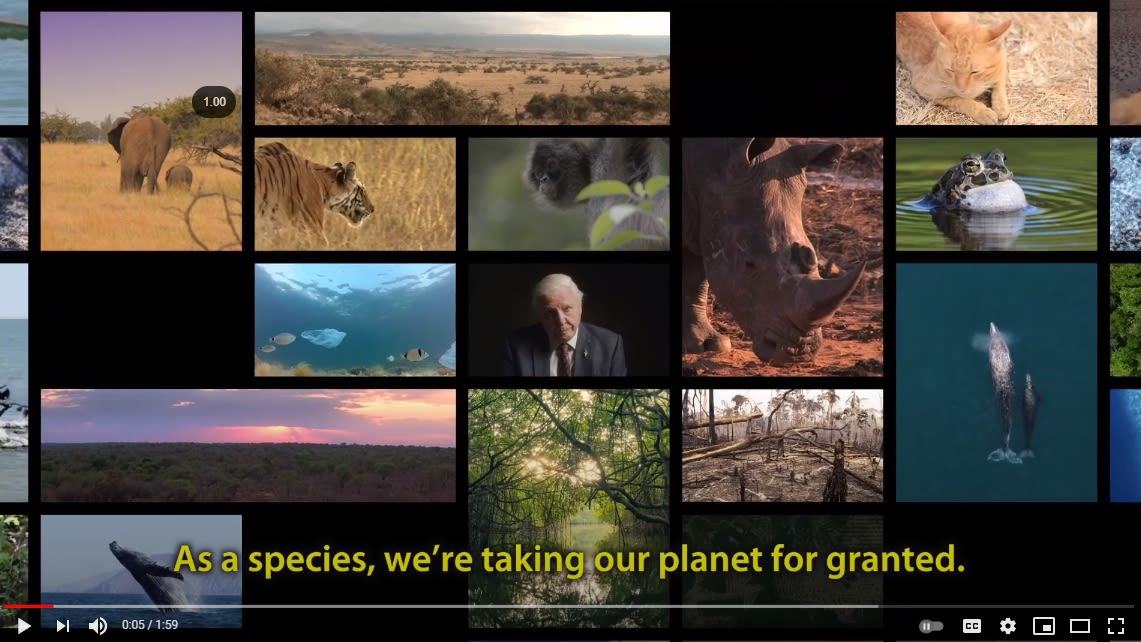Like water for tigers
Protecting tigers in the remote Himalayan kingdom of Bhutan by increasing local food security
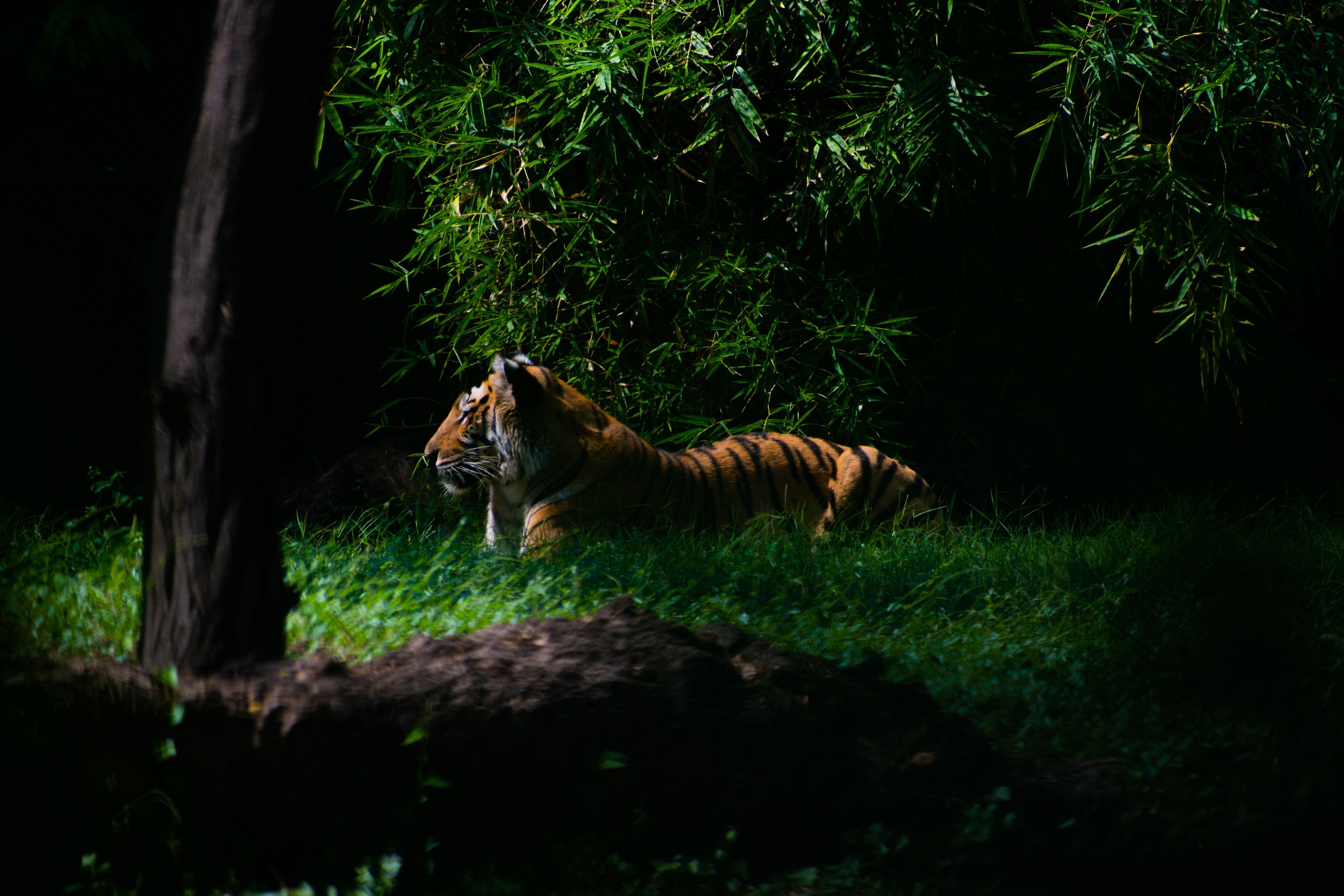
Year of the Tiger
As we enter the Year of the Tiger, characterized by universal respect and reverence for its namesake creature’s unique passion and fearlessness, the animal’s defenders are drawing inspiration from its enthusiasm and dynamism.
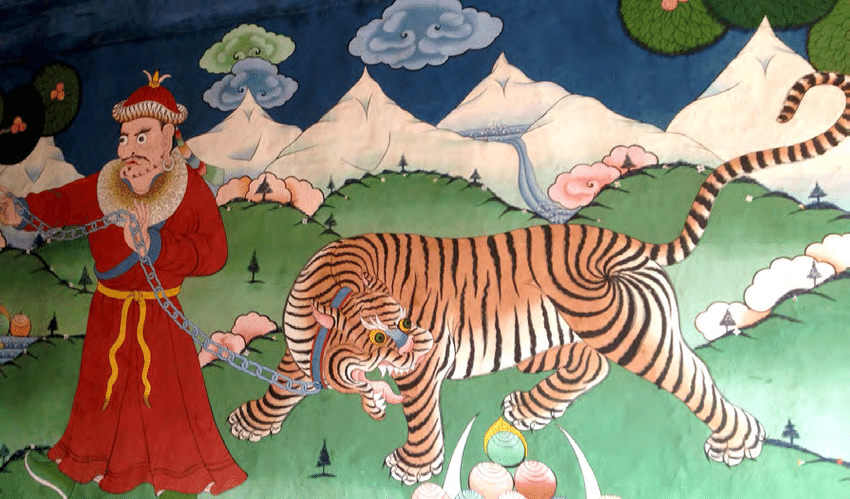
Mural depicting tiger on the wall of the entrance to Lamaigoenpa Palace, Bhutan.
In Bhutan, the Royal Manas National Park is home to countless valuable plant and wildlife species, including endangered animals such as one-horned rhinoceros, golden langur, Rufous-necked hornbills, Asiatic water buffalo and the Asian elephant, and rare migratory fish such as the golden mahseer and chocolate mahseer.
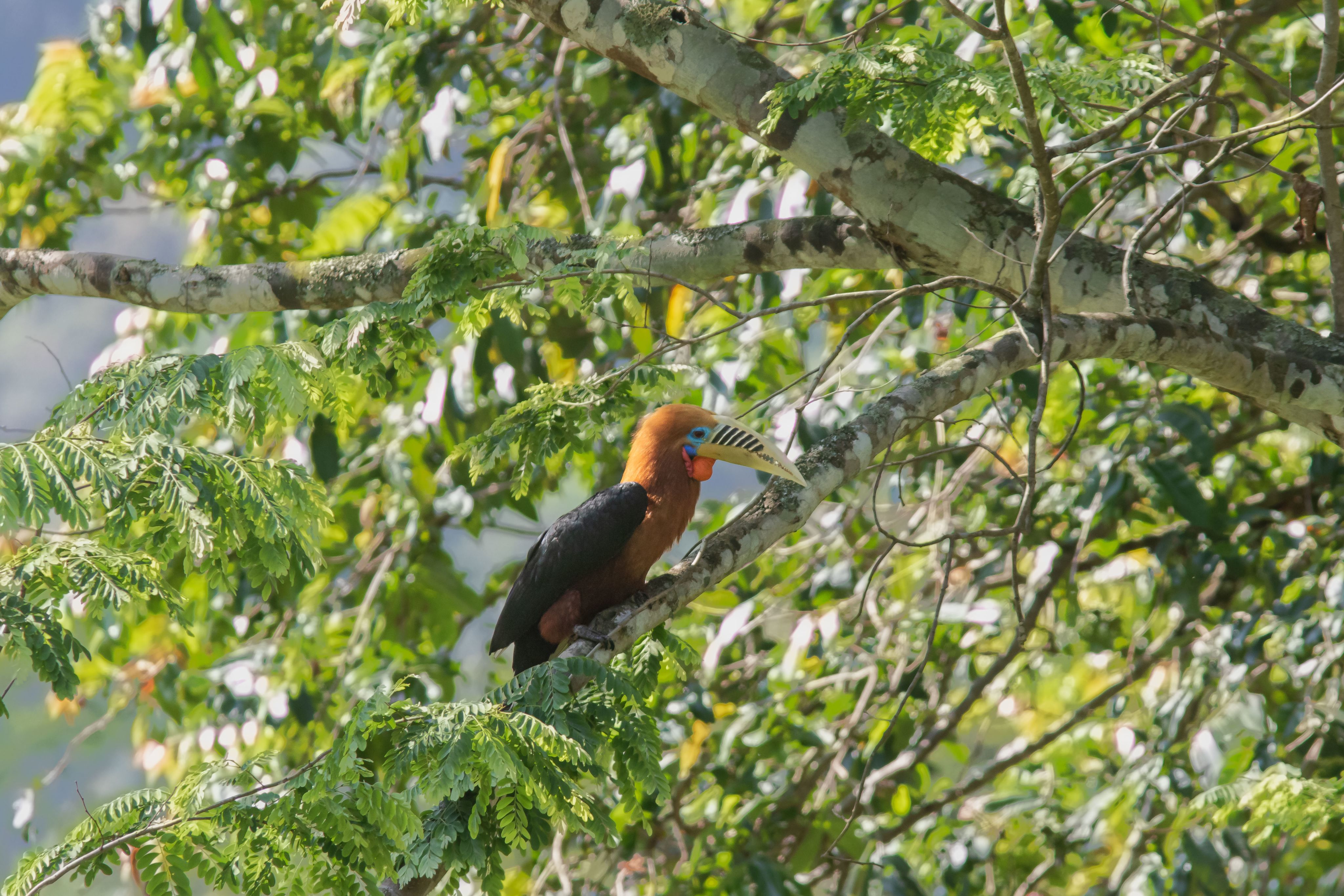
Rufous-necked hornbill in RMNP. Categorized as vulnerable by the International Union for Conservation of Nature (IUCN) and Birdlife international, the presence of this large bird can indicate a healthy forest. Photo: Joshua F. Goldberg/BES
It is also one Bhutan's tiger strongholds.
In the Royal Manas National Park ecosystem, tigers serve as a keystone species, affecting many other organisms through the complex web of life.
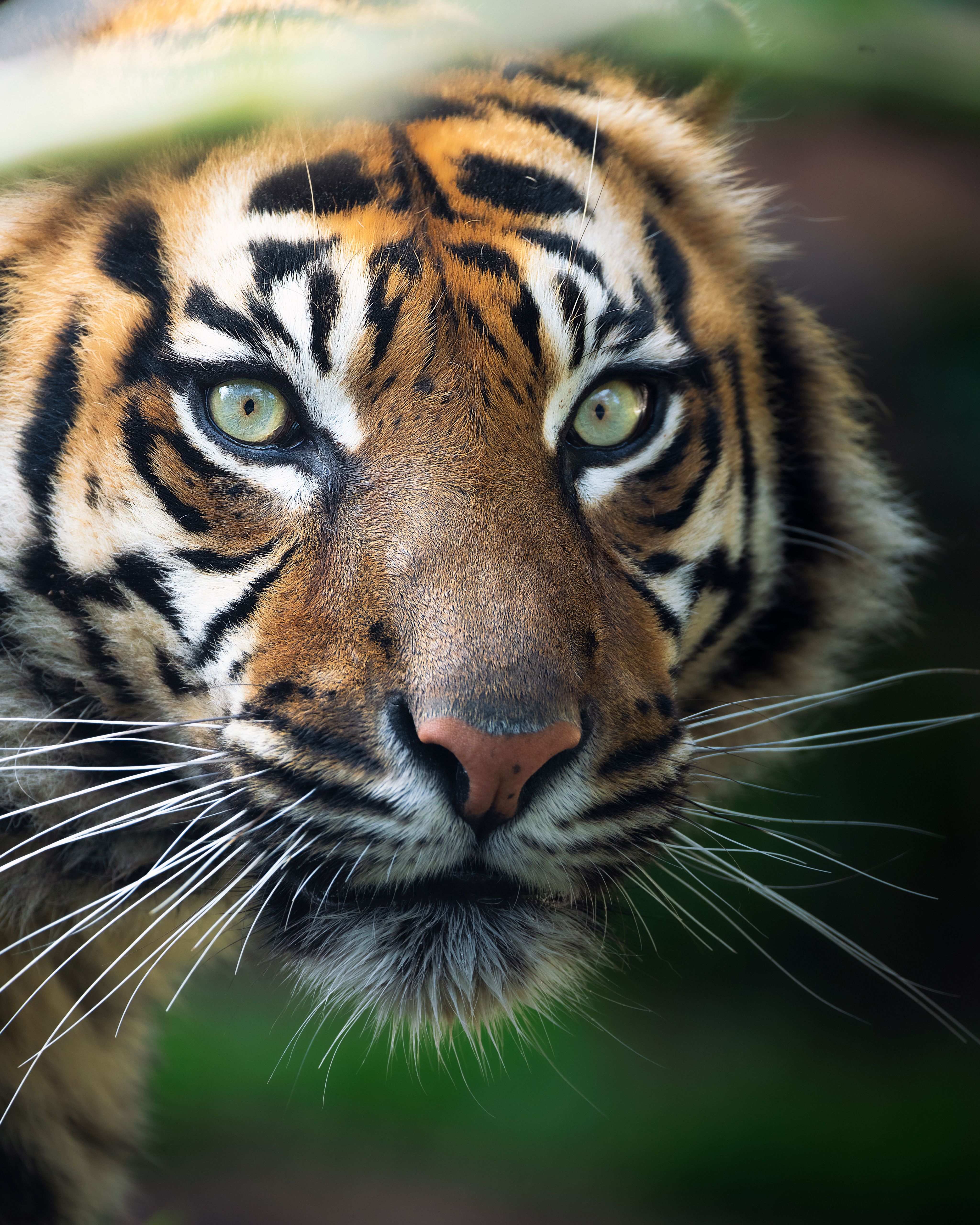
Photo: Gabriele Brancati/Pexels.com
Keystone species have large impacts on the ecosystems where they live even though they may be uncommon or rare; their presence can help define an entire ecosystem. Without the keystone species, an ecosystem would be dramatically different or collapse altogether.
Therefore, tigers are a compelling symbol of the park´s rich biodiversity and a key indicator of its health.
The park is the core habitat for tigers in Bhutan, and a hotspot for poaching due to its proximity to Indian borders that provide a gateway to illegal markets.
In addition to poaching, retaliatory killings of tigers and their prey are a major threat to conservation in Bhutan, as the wildlife habitats overlap with human settlements.
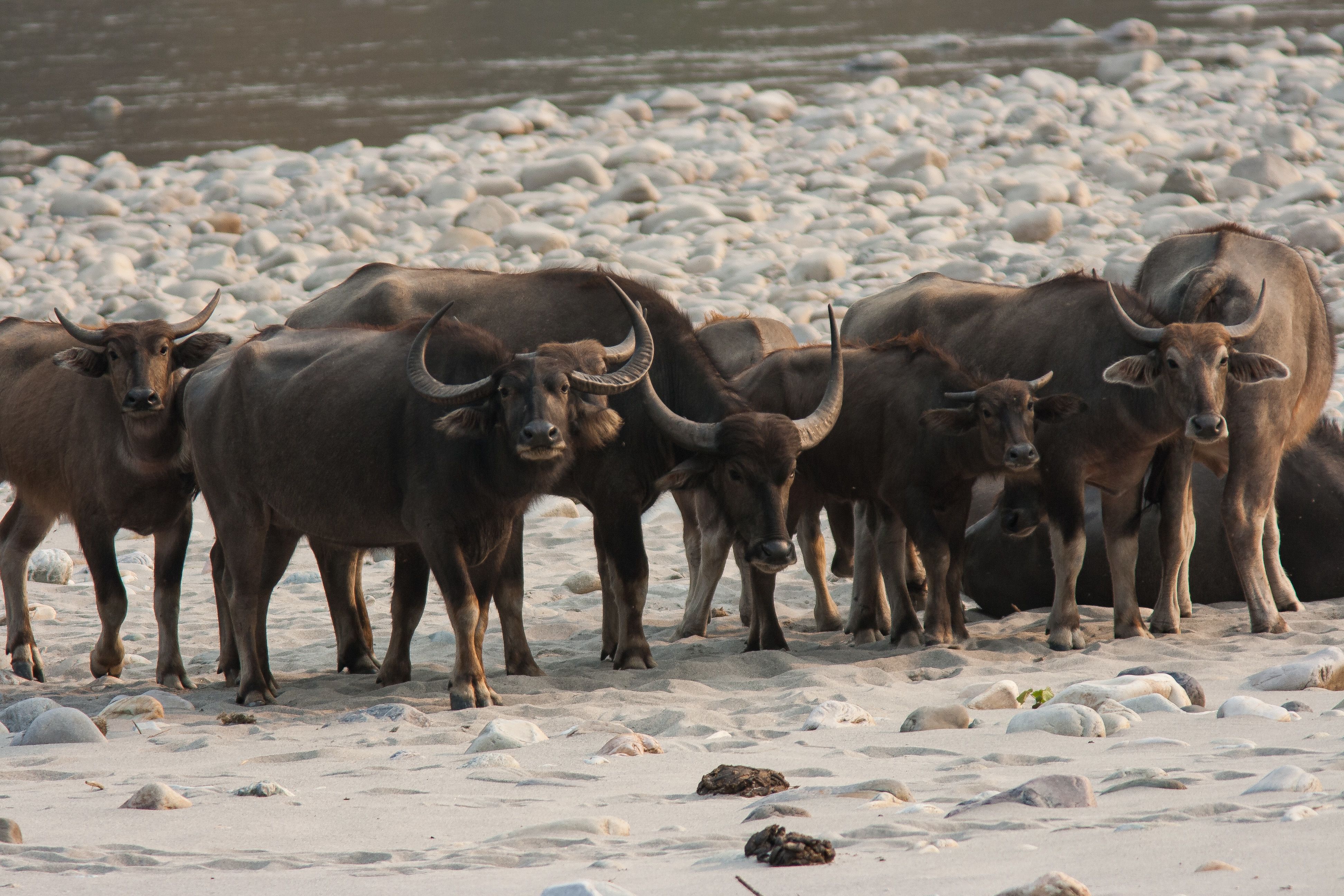
Asiatic water buffalo in RMNP. Photo: Joshua F. Goldberg/BES
The Bhutan Tiger Center estimates that Bhutan (and adjoining areas of India) has lost at least 19 adult tigers from 2012-2019, mostly to poaching – an eye-watering toll for a species with only ≈100 individuals remaining in the area.
Meeting the conservation challenge to protect tigers and other wildlife requires not only educating people about the importance of these species, but also providing alternative, sustainable livelihoods for people sharing landscapes with wildlife.

Mural depicting tiger on the wall of the entrance to Lamaigoenpa Palace, Bhutan.
Mural depicting tiger on the wall of the entrance to Lamaigoenpa Palace, Bhutan.

Rufous-necked hornbill in RMNP. Categorized as vulnerable by the International Union for Conservation of Nature (IUCN) and Birdlife international, the presence of this large bird can indicate a healthy forest. Photo: Joshua F. Goldberg/BES
Rufous-necked hornbill in RMNP. Categorized as vulnerable by the International Union for Conservation of Nature (IUCN) and Birdlife international, the presence of this large bird can indicate a healthy forest. Photo: Joshua F. Goldberg/BES

Photo: Gabriele Brancati/Pexels.com
Photo: Gabriele Brancati/Pexels.com

Asiatic water buffalo in RMNP. Photo: Joshua F. Goldberg/BES
Asiatic water buffalo in RMNP. Photo: Joshua F. Goldberg/BES
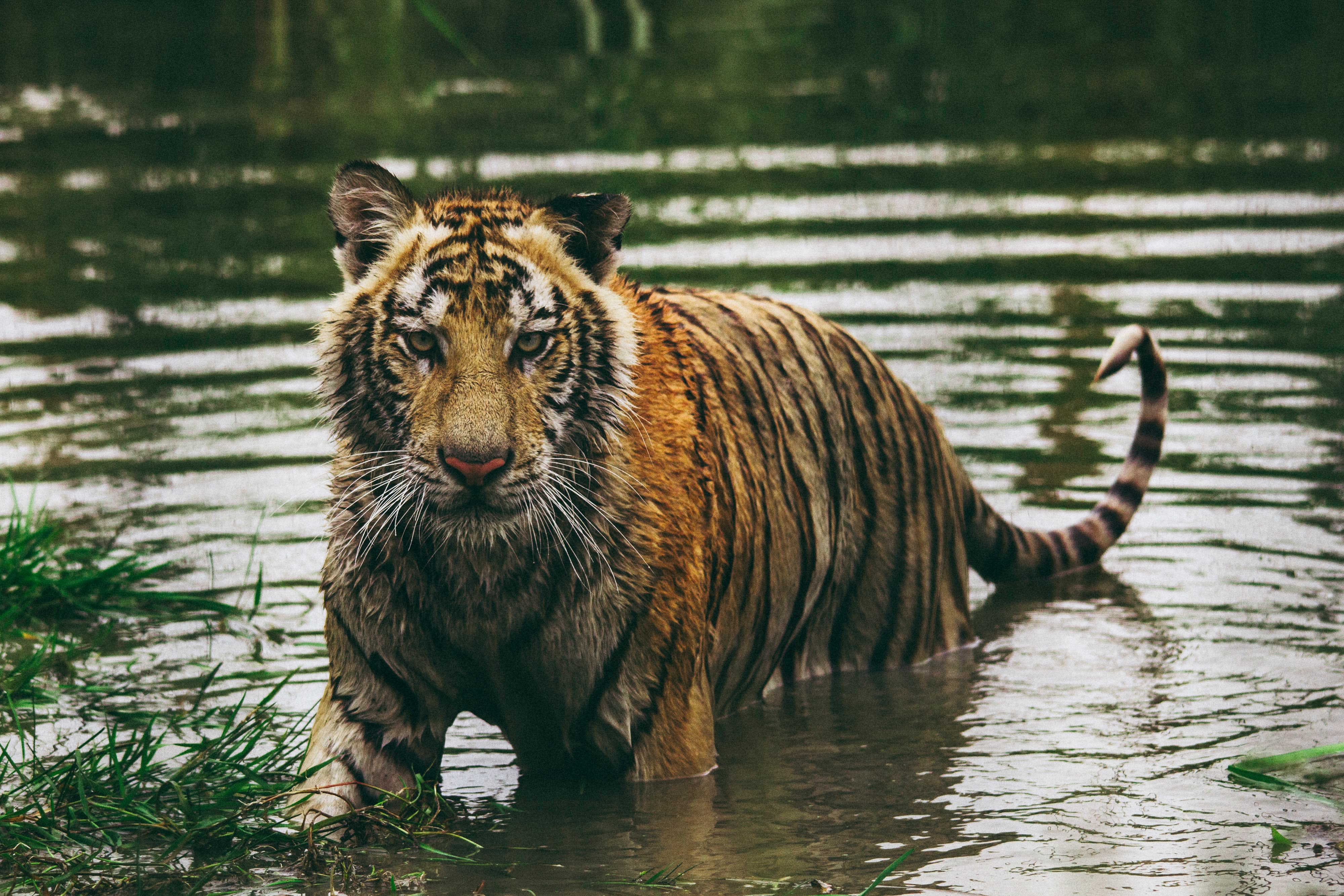
Photo: Frida Lanenrstrom/Unsplash.com
Photo: Frida Lanenrstrom/Unsplash.com
Tourism and conservation
Tourism offers one such opportunity.
Sangay Penjor, Namgay Wangchuk and Lam Dorji are three of the nine members of the River Guides of Panbang who are pursuing this opportunity.
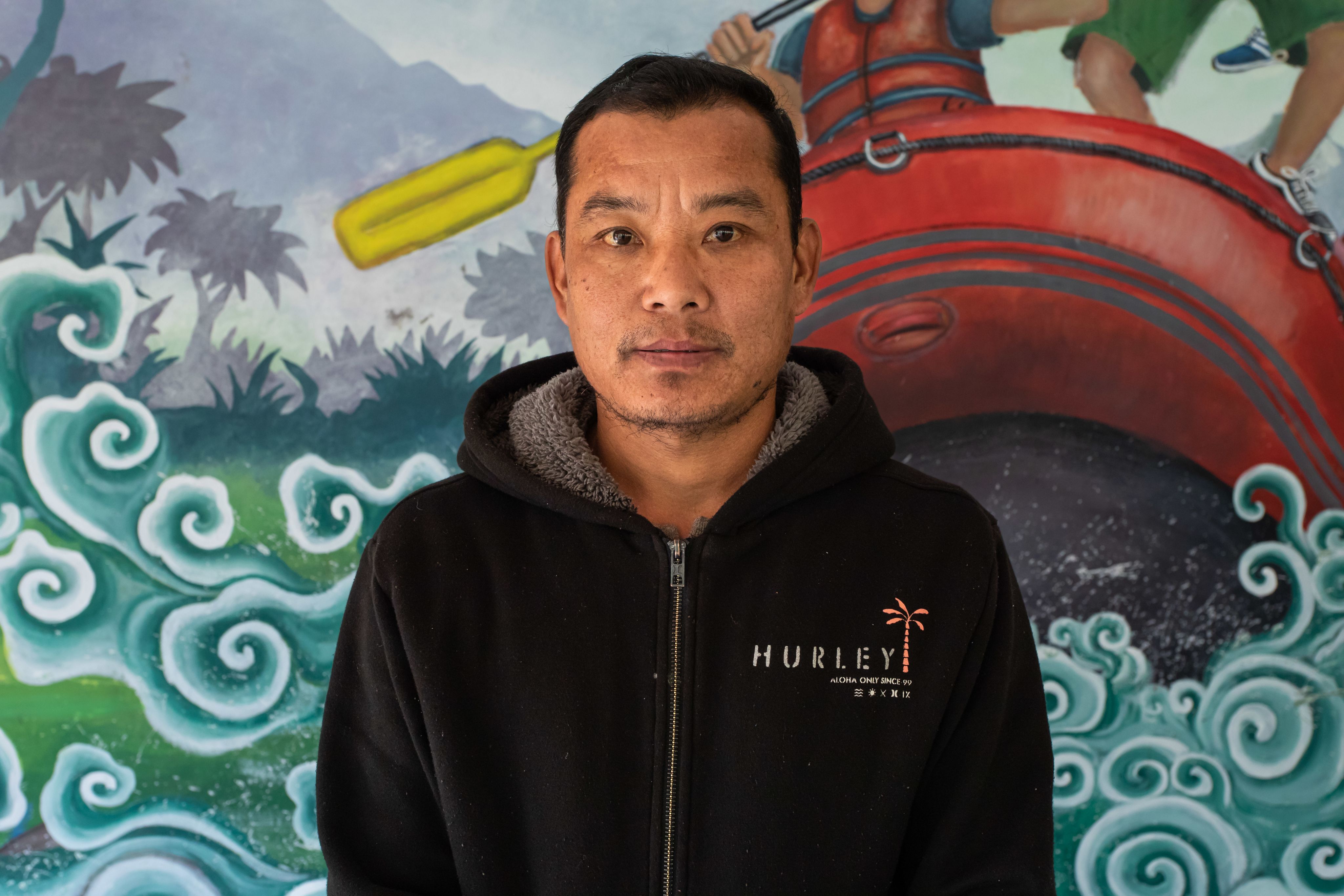
Lam Dorji from the River Guides of Panbang. Photo: Joshua F. Goldberg/BES
River Guides of Panbang is a community-based rafting company that also runs a lodge in Panbang, a small town of about 1,600 people that lies adjacent to Royal Manas National Park and is only 13km from the Indian border.
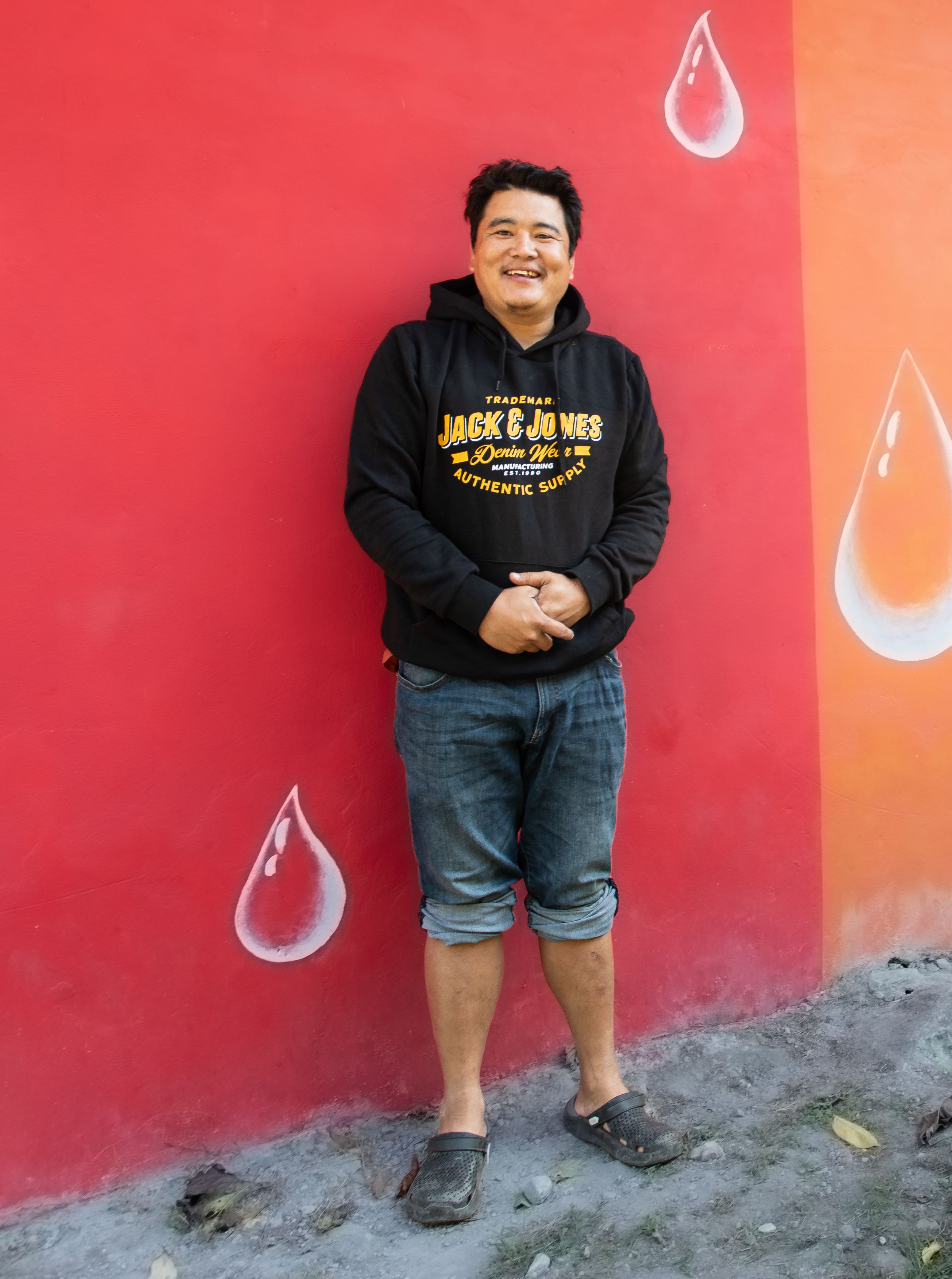
Namgay Wangchuk from the River Guides of Panbang. Photo: Joshua F. Goldberg/BES
River Guides of Panbang members have been running their tourism business for close to 10 years, simultaneously contributing to the well-being of their community as well as conservation goals.
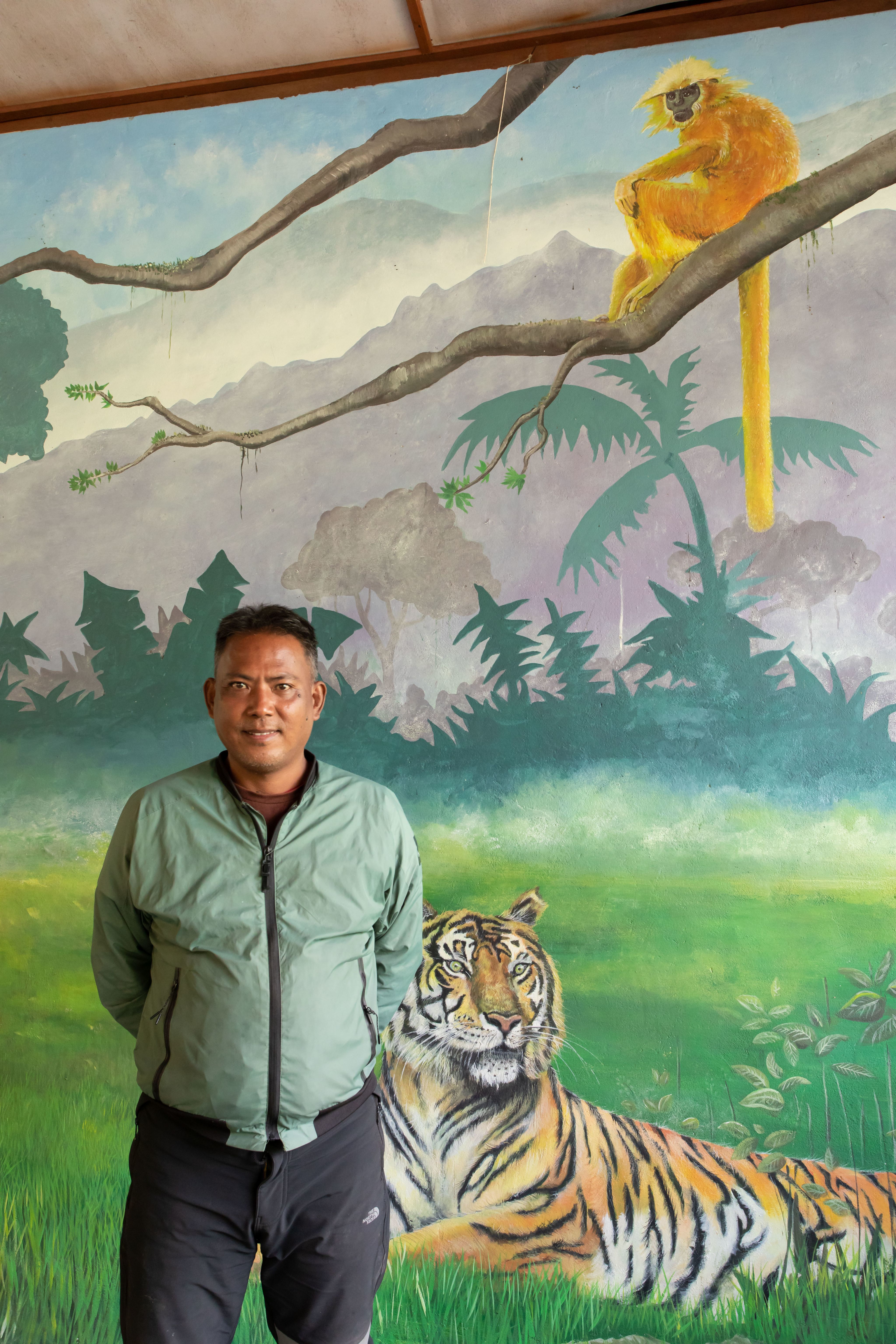
Sangay Penjor from the River Guides of Panbang. Photo: Joshua F. Goldberg/BES
As certified White-Water Rescue Technicians, RGP members have played a vital role in national river search and rescue missions; they have participated in curbing illegal fishing and poaching, and have engaged with their local community as well as neighbouring communities across the border to conserve their rich environment.

Lam Dorji from the River Guides of Panbang. Photo: Joshua F. Goldberg/BES
Lam Dorji from the River Guides of Panbang. Photo: Joshua F. Goldberg/BES

Namgay Wangchuk from the River Guides of Panbang. Photo: Joshua F. Goldberg/BES
Namgay Wangchuk from the River Guides of Panbang. Photo: Joshua F. Goldberg/BES

Sangay Penjor from the River Guides of Panbang. Photo: Joshua F. Goldberg/BES
Sangay Penjor from the River Guides of Panbang. Photo: Joshua F. Goldberg/BES
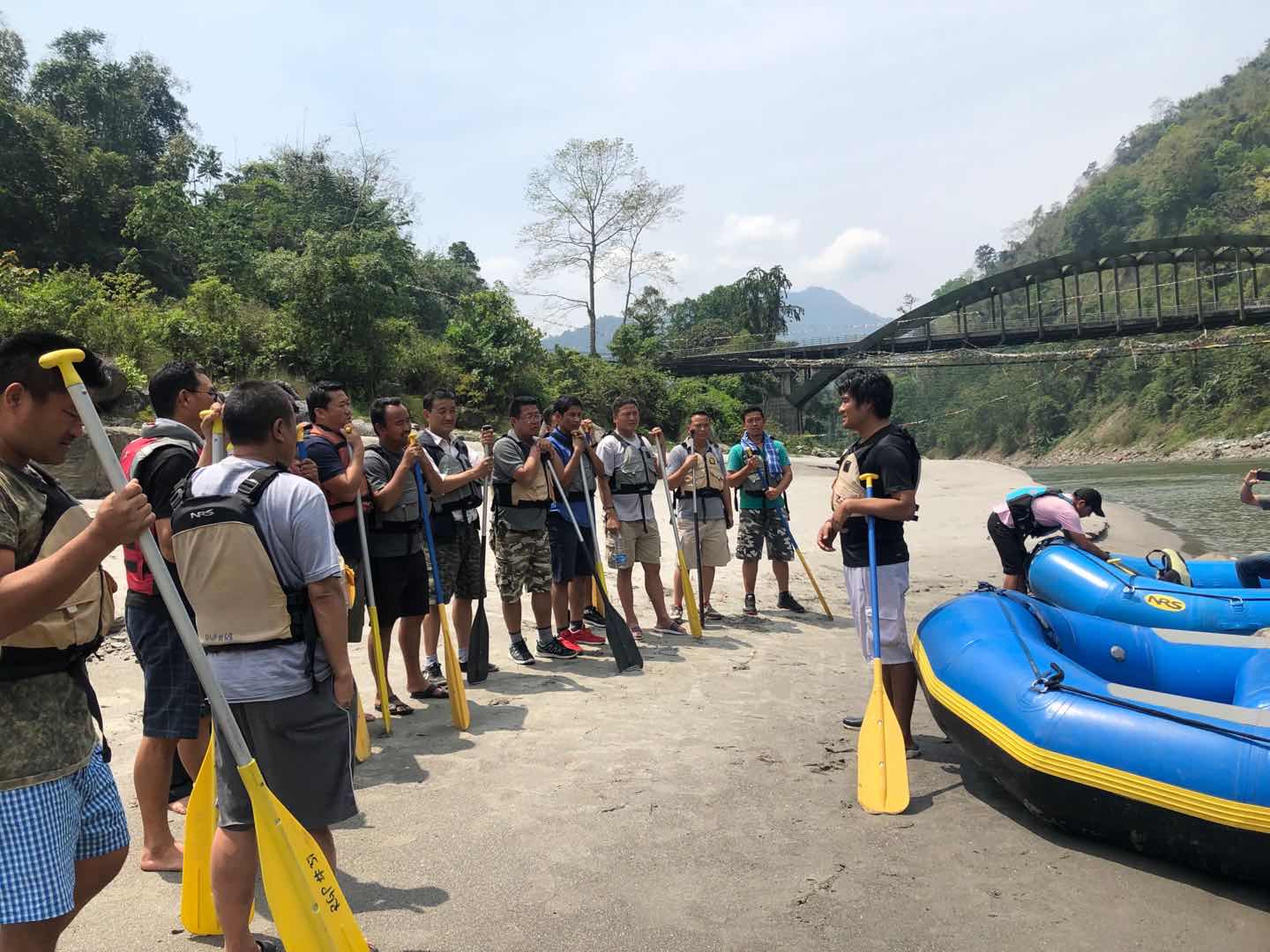

River Guides of Panbang. Photo: Bhutan Ecological Society
River Guides of Panbang. Photo: Bhutan Ecological Society
Grinding halt
However, the COVID-19 pandemic brought their tourism business to a grinding halt and acutely impacted their livelihoods and that of their community.
Into this gap, water – in the form of aquaponics – is now flowing.
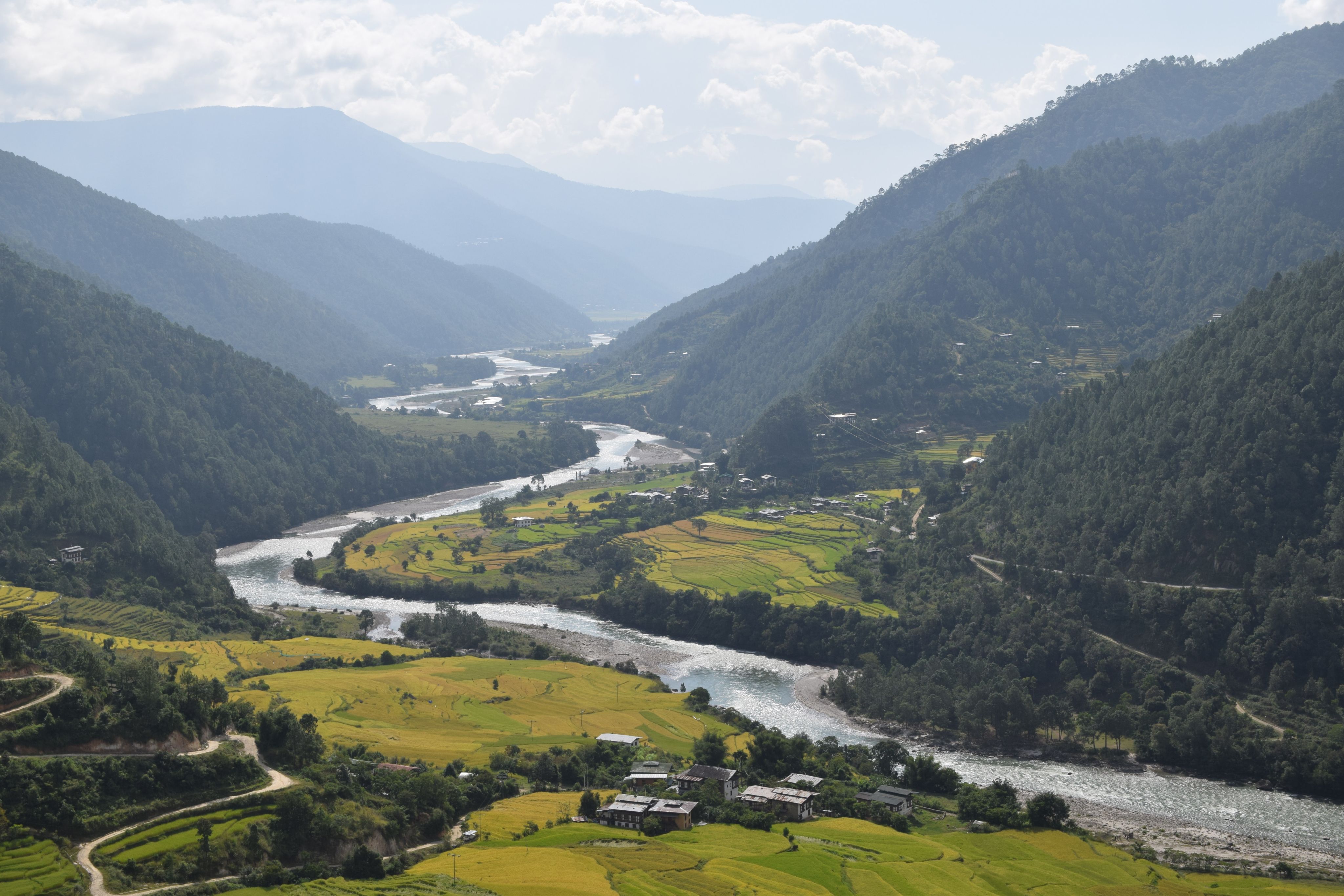
Aquaponics Pioneers
As a measure to build the community’s resilience to the economic and social impacts of the pandemic the Bhutan Ecological Society is pioneering aquaponic agriculture in Bhutan.
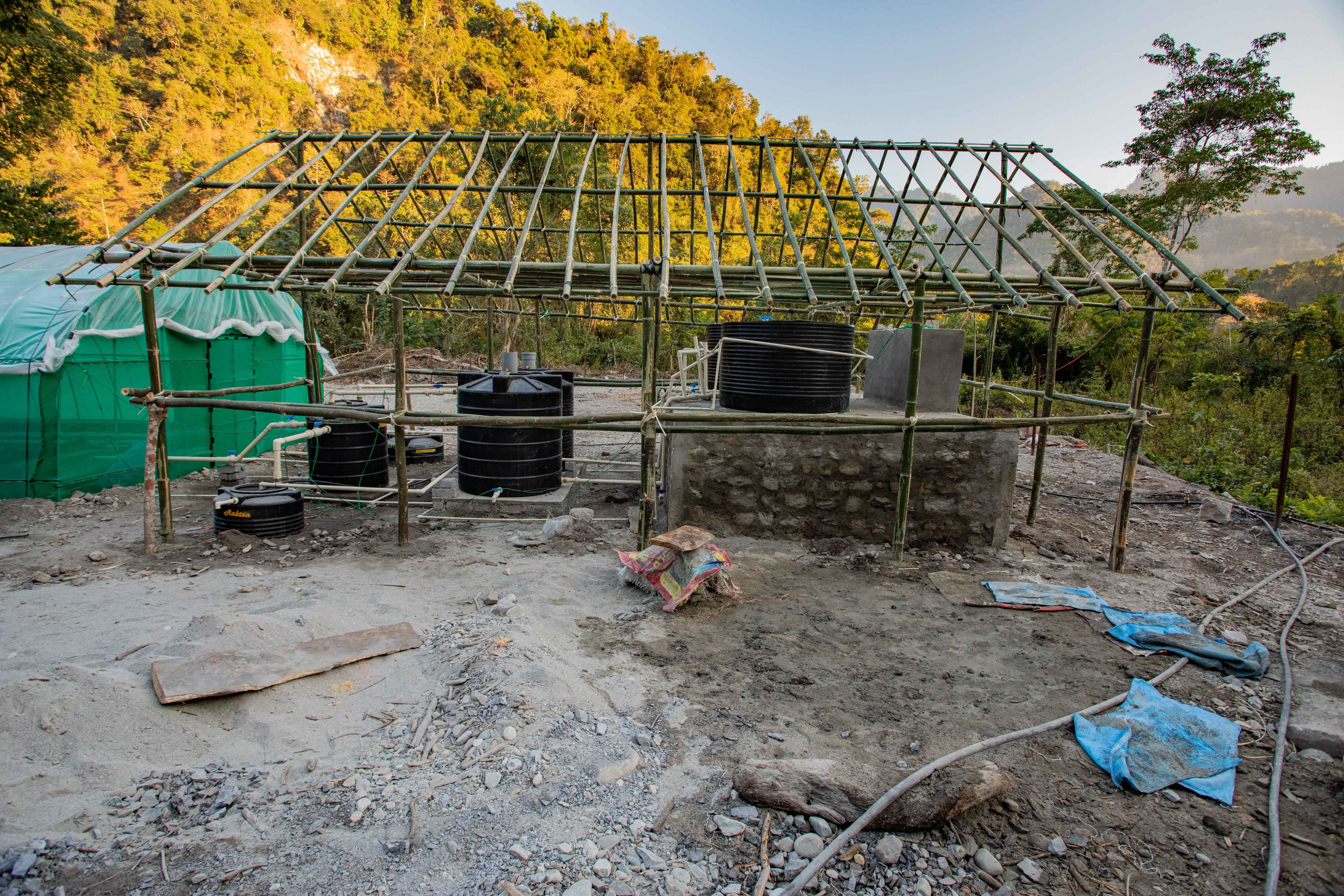
Aquaponic facility construction. Photo: Joshua F. Goldberg/BES
As an environmental NGO that works to create resilient and sustainable livelihoods that preserve the integrity of their ecosystems, the Bhutan Ecological Society chose the River Guides of Panbang (RGP) as a beneficiary and partner for the aquaponic project.
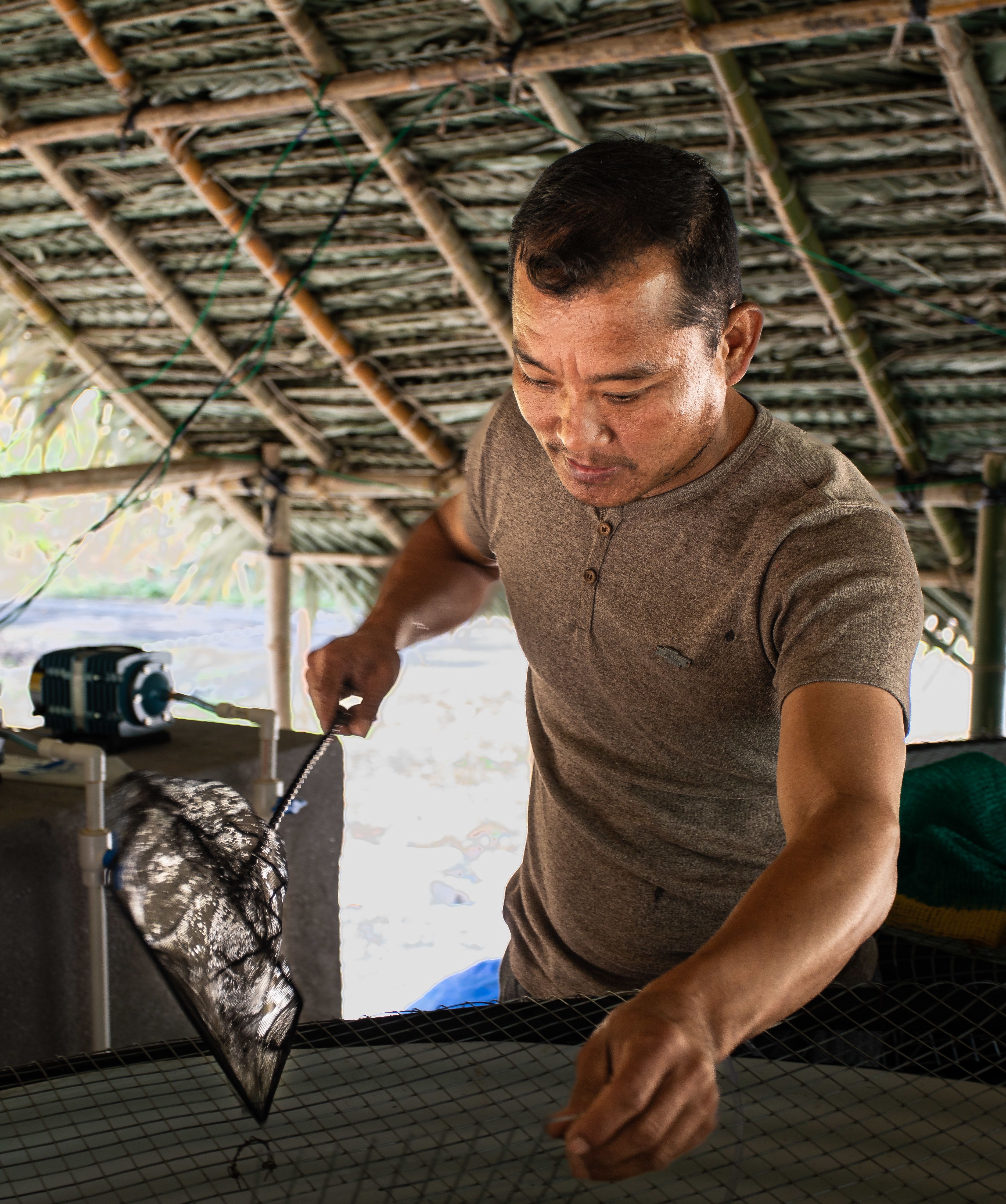
Lam Dorji, one of the River Guides of Panbang, working in the aquaponic facility. Photo: Joshua F. Goldberg/BES
RGP was chosen due to their proximity to the highly biodiverse Royal Manas National Park and the area’s manifest increase in vulnerability due to the impacts of COVID-19.
Aquaponics combines aquaculture (growing fish) with hydroponics (growing plants without soil) by developing a complex, circular agricultural ecology.
Nutrient-rich fish wastes are broken down by microbes into plant fertilizers, and by absorbing these nutrients, plants purify the water for fish.
Aquaponic systems can be extremely productive, yielding an abundance of vegetable crops and fish within a small space.
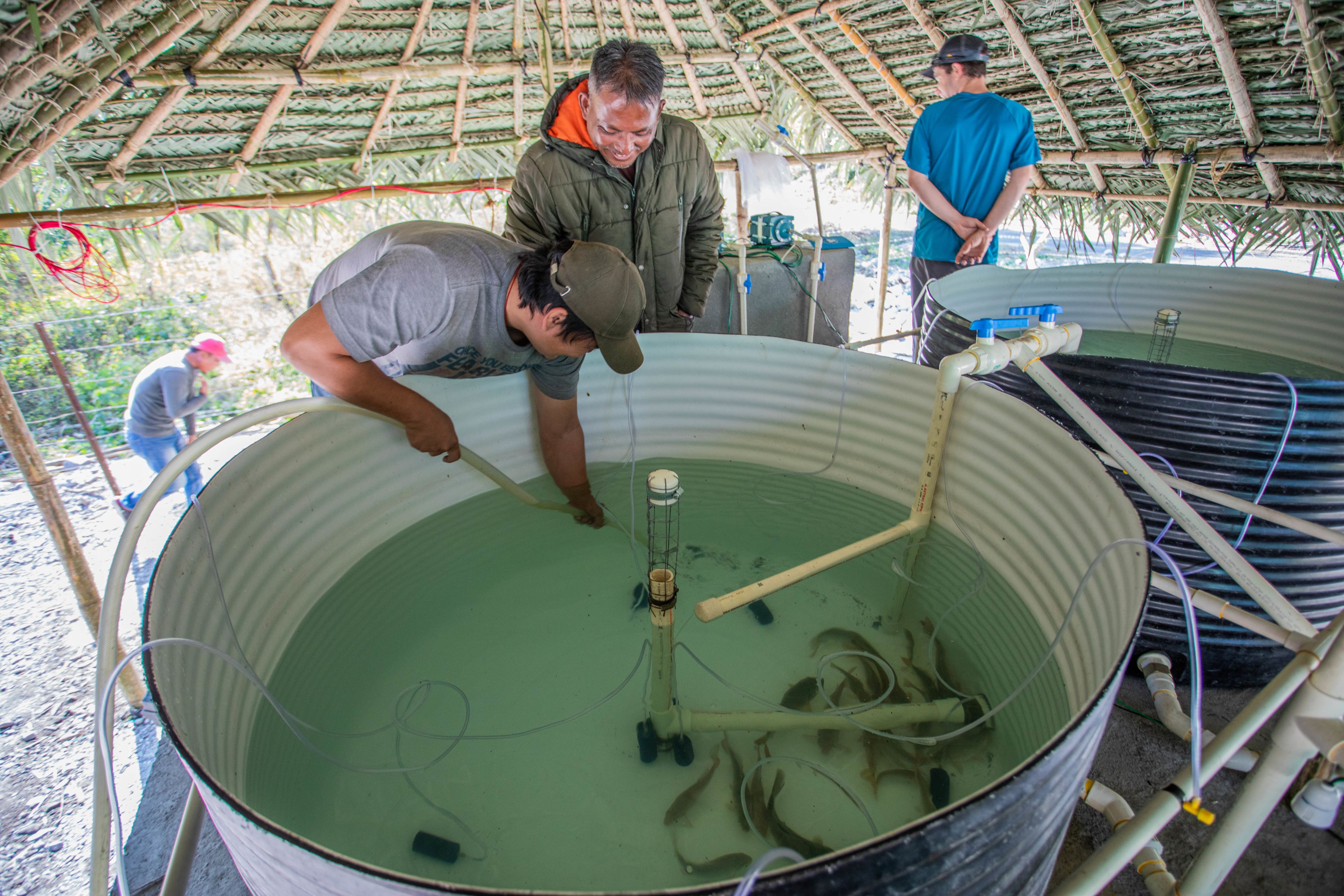
The introduction of fish (common carp Cyprinio carpio), sourced from the National Research and Development Center for Aquaculture in Gelephu in December 2021. These fish are extraordinarily hardy with low-risk of mortality. Photo: Joshua F. Goldberg/BES
The project is based on the understanding that if local communities living in the area surrounding Royal Manas National Park have enough to eat and can maintain their livelihoods from alternative economic activities, the unsustainable use of natural resources and habitat fragmentation will decrease.
Encroaching on the surrounding ecosystem for firewood or food contributes to fragmentation, which leaves tigers and their fellow fauna confined to ever-smaller areas, restricting animals’ movement and gene flow, and disrupting the health of the ecosystem overall.
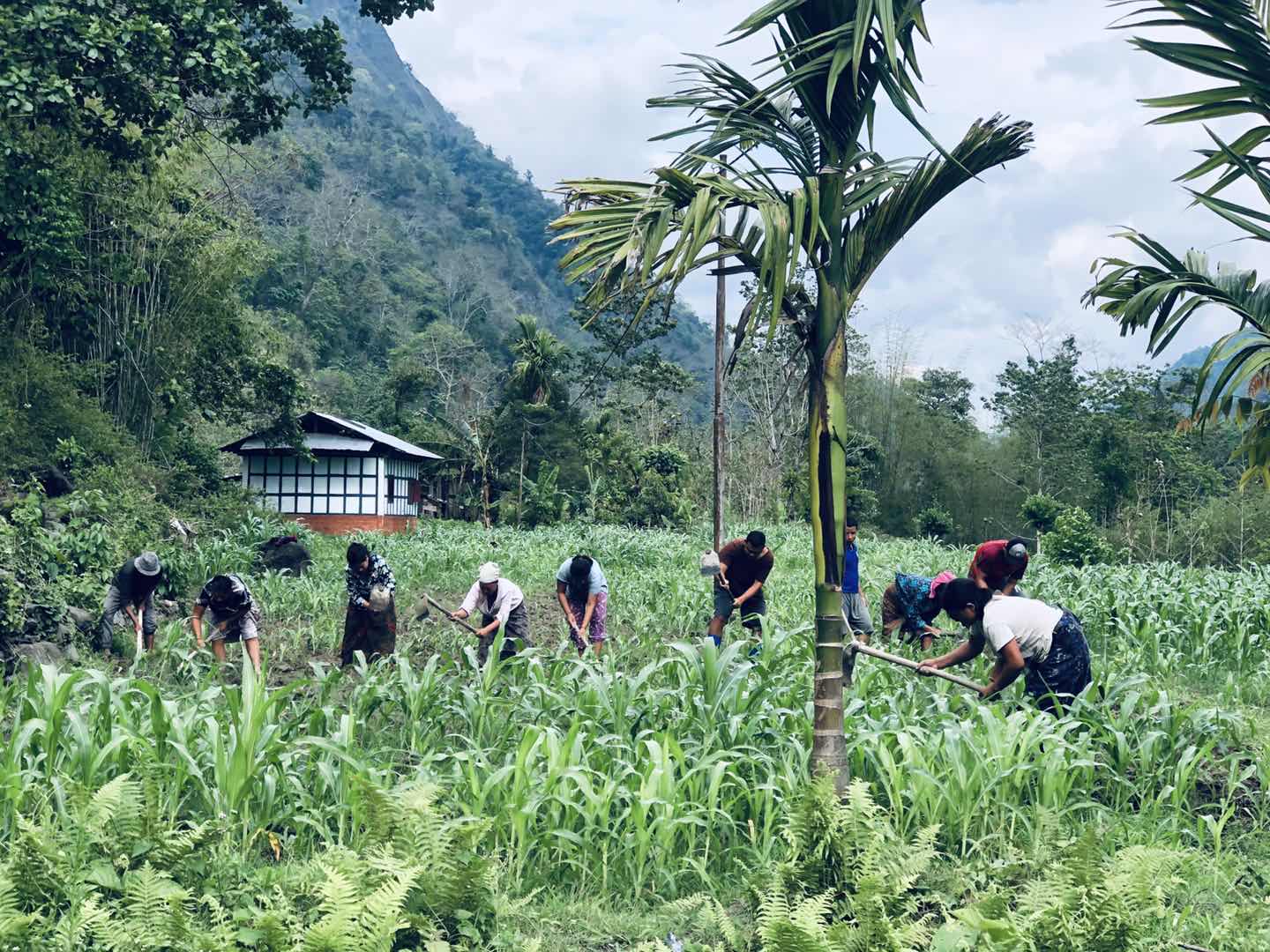
Local community around Royal Manas National Park farming. Photo: River Guides of Panbang/BES
But with an alternative, environmentally-sensitive source of food, the surrounding forest and habitat for tigers can be left intact.

Aquaponic facility construction. Photo: Joshua F. Goldberg/BES
Aquaponic facility construction. Photo: Joshua F. Goldberg/BES

Lam Dorji, one of the River Guides of Panbang, working in the aquaponic facility. Photo: Joshua F. Goldberg/BES
Lam Dorji, one of the River Guides of Panbang, working in the aquaponic facility. Photo: Joshua F. Goldberg/BES

The introduction of fish (common carp Cyprinio carpio), sourced from the National Research and Development Center for Aquaculture in Gelephu in December 2021. These fish are extraordinarily hardy with low-risk of mortality. Photo: Joshua F. Goldberg/BES
The introduction of fish (common carp Cyprinio carpio), sourced from the National Research and Development Center for Aquaculture in Gelephu in December 2021. These fish are extraordinarily hardy with low-risk of mortality. Photo: Joshua F. Goldberg/BES

Local community around Royal Manas National Park farming. Photo: River Guides of Panbang/BES
Local community around Royal Manas National Park farming. Photo: River Guides of Panbang/BES
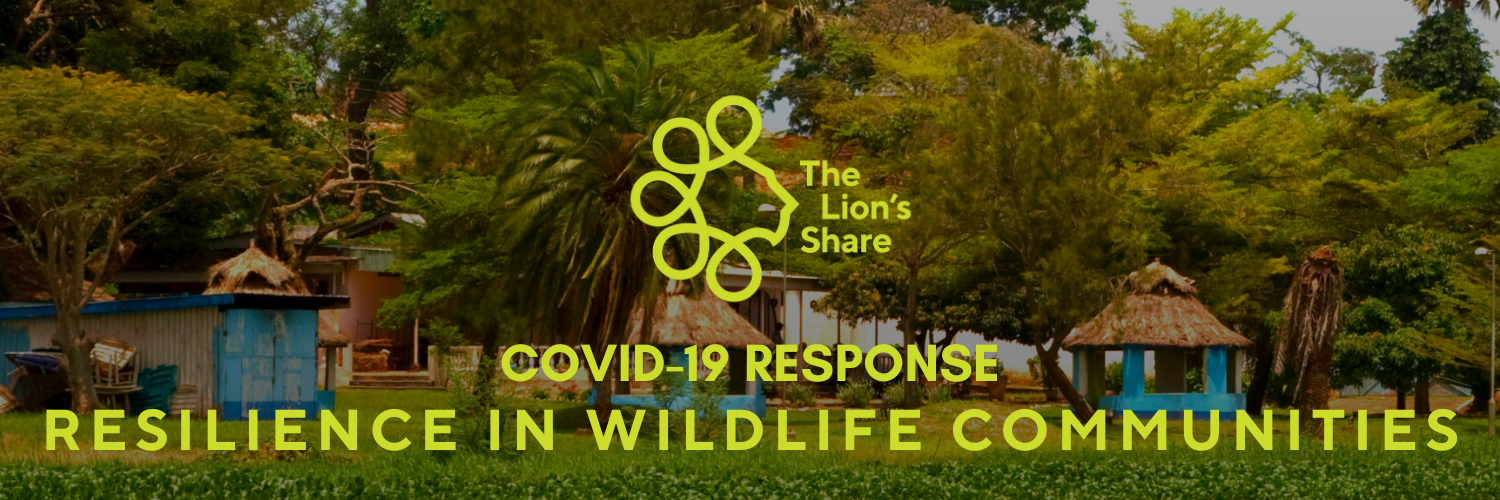
Resilience in Wildlife Community Grants
In recognition of Covid-19’s world-altering effects, The Lion’s Share, and the Global Environment Facility’s Small Grants Programme - implemented by UNDP - made a call for proposals in April 2020 to support communities dependent on wildlife-based tourism.
The nine successful recipients of grants from the ‘Covid-19 Response: Resilience in Wildlife Communities’ initiative were selected from over 1,600 proposals by organizations across 106 countries.
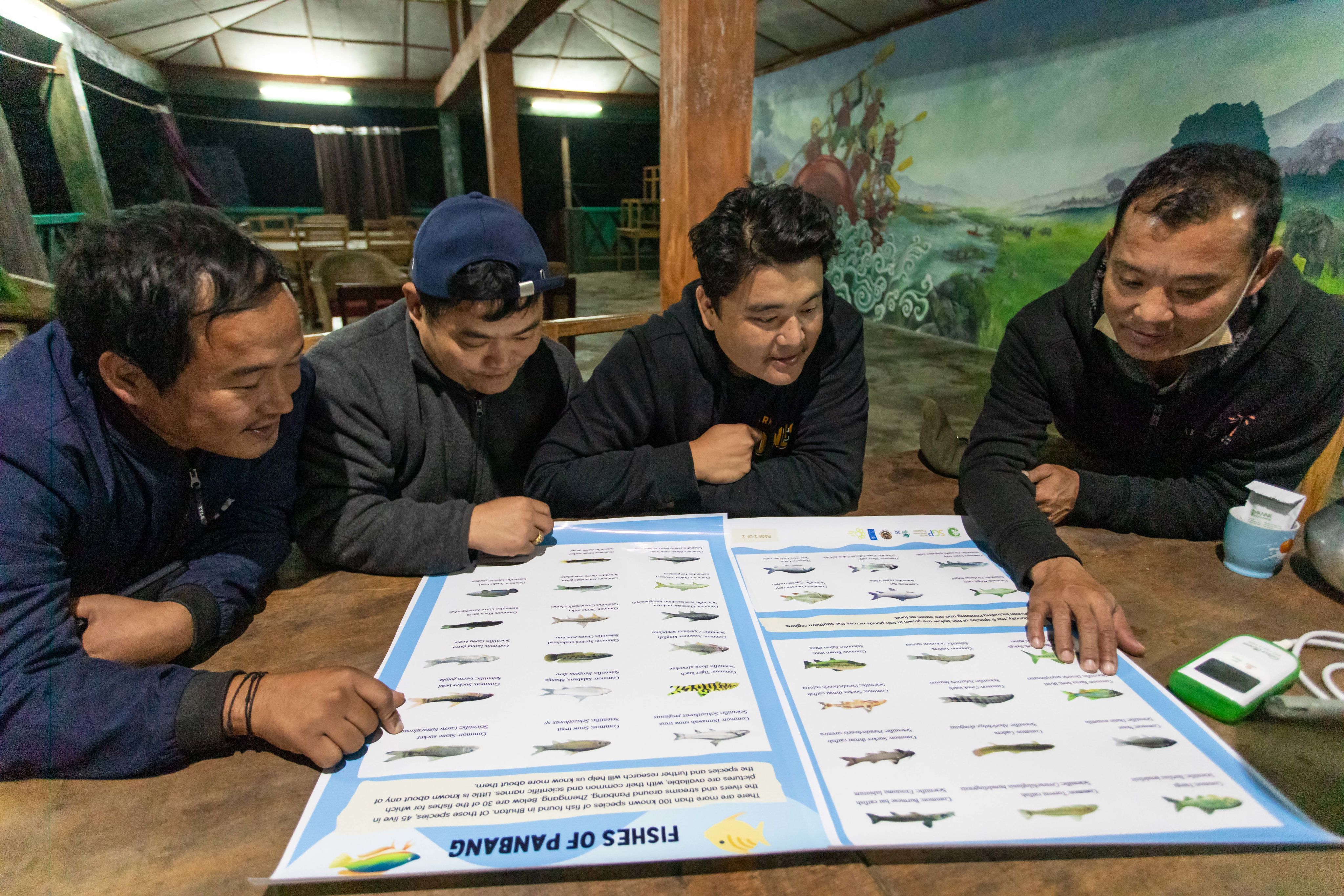
BES training RGP on the fishes that live in the rivers of Panbang. Photo: Joshua F. Goldberg/BES
These projects have been working to build resilience in communities in wildlife-rich areas and support the continued protection of threatened wildlife in their remaining strongholds despite pandemic hardships.
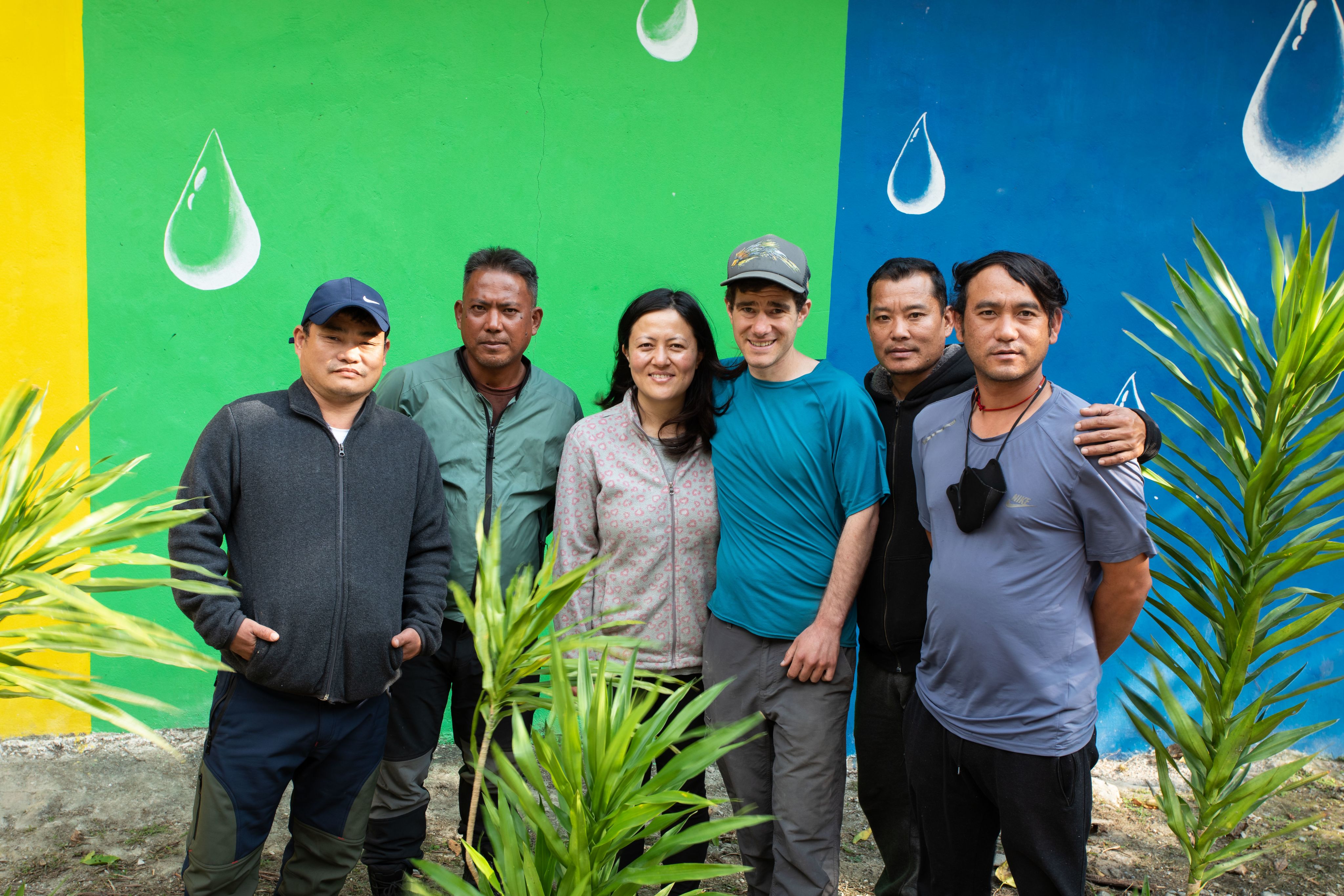
BES/RGP group picture. Photo: Joshua F. Goldberg/BES
As a part of this effort to foster sustainable, eco-conscious development in the wake of COVID-19, the grant for the Bhutan Ecological Society is working with the cooperation of the Royal Government of Bhutan to pioneer aquaponics.

BES training RGP on the fishes that live in the rivers of Panbang. Photo: Joshua F. Goldberg/BES
BES training RGP on the fishes that live in the rivers of Panbang. Photo: Joshua F. Goldberg/BES

BES/RGP group picture. Photo: Joshua F. Goldberg/BES
BES/RGP group picture. Photo: Joshua F. Goldberg/BES
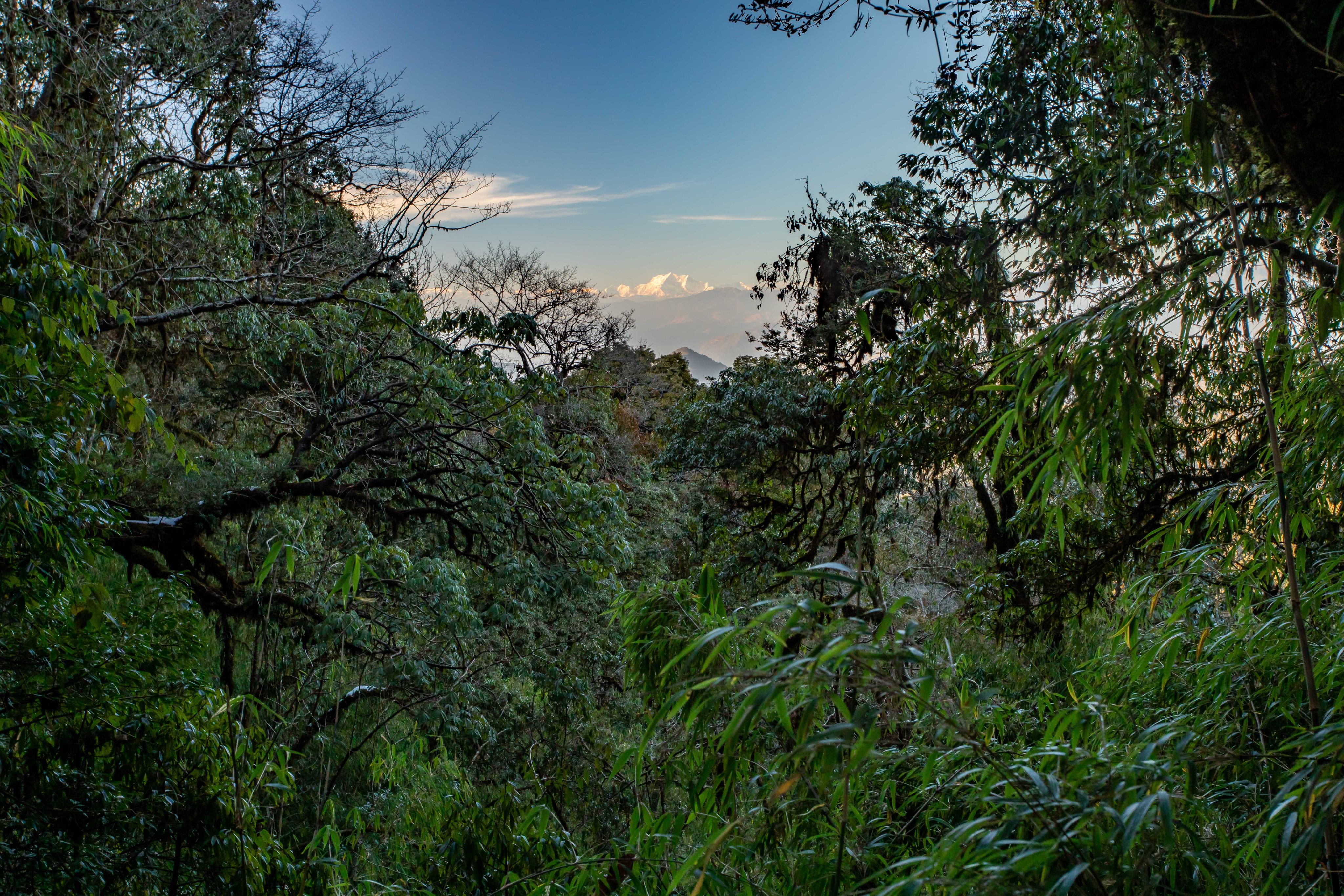
View of Gangkhar Puensum from Manas, Bhutan. Gangkhar Puensum is the highest mountain in Bhutan (7570m) and the highest unclimbed mountain in the world. Photo: Joshua F. Goldberg/BES
View of Gangkhar Puensum from Manas, Bhutan. Gangkhar Puensum is the highest mountain in Bhutan (7570m) and the highest unclimbed mountain in the world. Photo: Joshua F. Goldberg/BES
The science of farming
For the community of Panbang, aquaponics represents a key alternative source of income and food security.
Additionally, this new, ecological approach to farming can improve the climate resilience of the community food supply by growing crops within greenhouses protected from harsh conditions and pests.
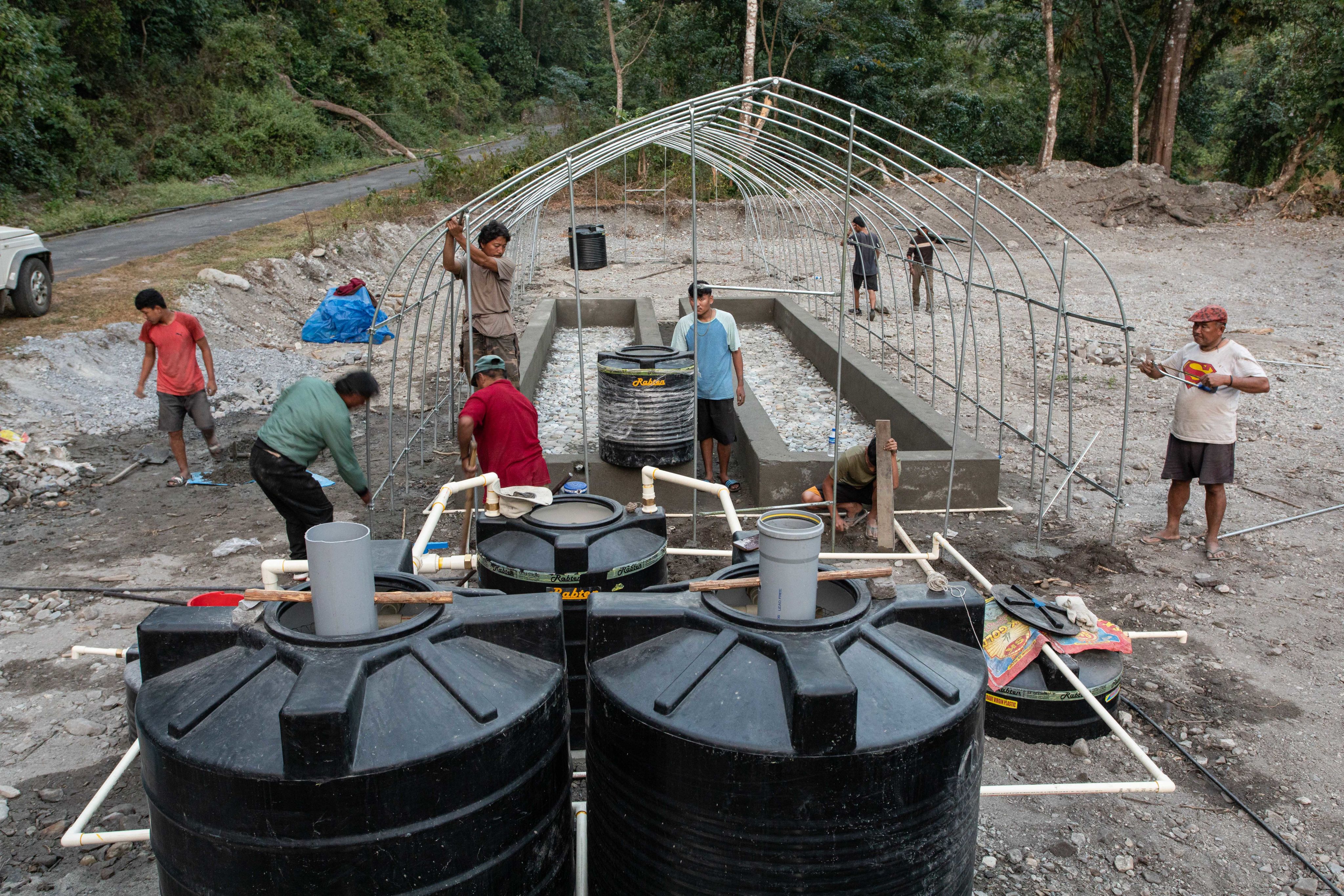
Photo: Aquaponic facility construction. Photo: Joshua F. Goldberg/BES
The small, but productive, footprint of aquaponics can also reduce the pressure on local natural resources and decrease human-wildlife conflict in the biodiverse landscape of Royal Manas National Park.
With a secure source of food, community members can reduce their use of natural resources within wildlife habitats, leaving those areas as intact sanctuaries.
The aquaponic facility is already fostering a greater appreciation of ecological processes among RGP staff including Sangay, Namgay, Lam and their colleagues.
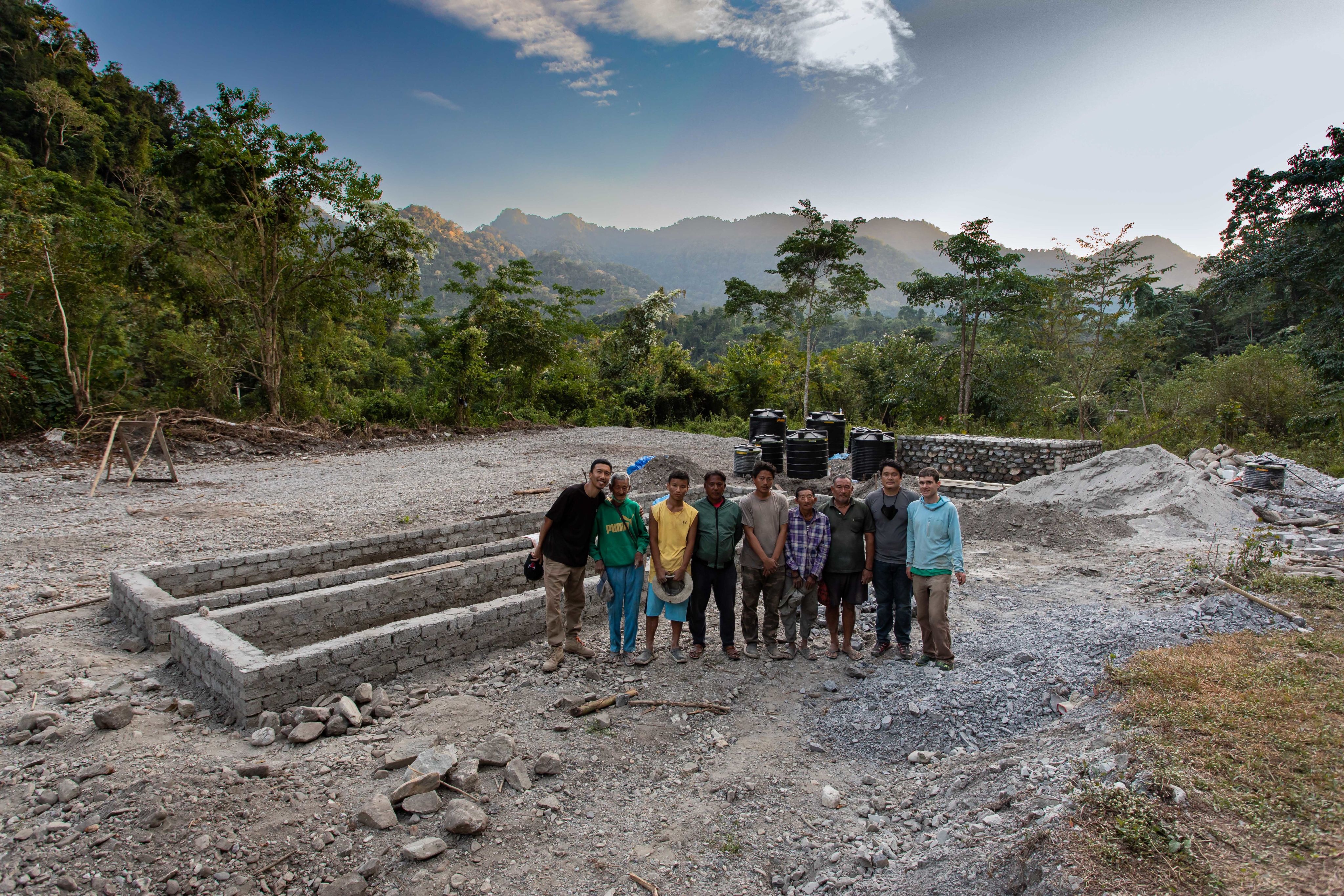
Group shot as the aquaponic facility construction gets underway. Photo: Joshua F. Goldberg/BES
“The biggest impact of the aquaponics project will be on education – it will not only raise awareness of conservation and ecology, but also teach us about a new and innovative method of farming that has never been tried before in Bhutan. In young children, this facility will give them a visible and tangible example of the science of farming, which we have been introduced to through the BES project.
More importantly, if we get this right, our project can be a game changer for agriculture and have multiple benefits, such as reducing human-wildlife conflict, saving cost on electric farming and reducing climate-induced threats to agriculture.”

Photo: Aquaponic facility construction. Photo: Joshua F. Goldberg/BES
Photo: Aquaponic facility construction. Photo: Joshua F. Goldberg/BES

Group shot as the aquaponic facility construction gets underway. Photo: Joshua F. Goldberg/BES
Group shot as the aquaponic facility construction gets underway. Photo: Joshua F. Goldberg/BES
First of its kind
Aquaponic agriculture had not been previously implemented in Bhutan.
The RGP aquaponics system serves as an inspiration to the community, as well as the nation, to build and sustain resilient landscapes that provide for human needs and support critical ecological processes and biodiversity.
The RGP members see multiple potential benefits from the aquaponic project – the facility offers an added attraction for visitors, and means that they will be able to serve fresh vegetables and herbs from the aquaponic farm to their guests.
There is also the possibility to expand to commercial production that caters to the local community, which currently struggles to grow sufficient fresh vegetables, particularly during the summer monsoon season.
All of these outcomes facilitate the conservation of the local natural environment by providing ecologically conscious livelihoods that do not depend upon unsustainable extraction from natural areas.
“Although we are working with cultured fish at the moment, I look forward to a time when we can work with local fish in our aquaponic facility, which will add to the attraction at the Jungle Lodge and also increase knowledge of local fish and aquatic life.”
In the future, aquaponics – perhaps utilizing local fish and aquatic life – could be implemented more widely in Bhutan, reducing the human-wildlife conflicts and habitat fragmentation that make tiger survival so difficult.
Projects like Bhutan’s aquaponics initiative can therefore have positive consequences well beyond the Year of the Tiger.
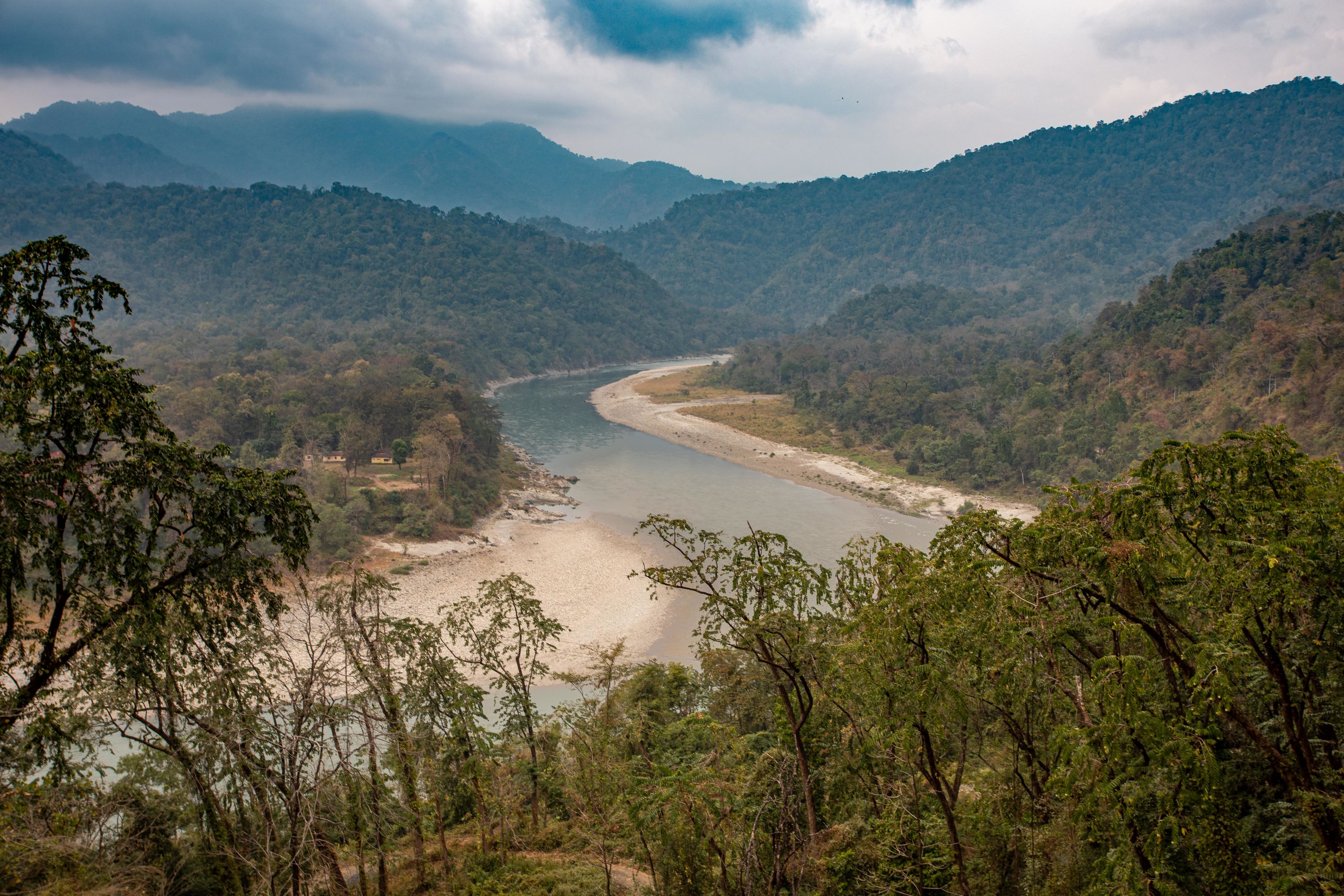
Manas River, Bhutan. Photo: Joshua F. Goldberg/BES
Manas River, Bhutan. Photo: Joshua F. Goldberg/BES
Facilitating action
Introduced by Sir David Attenborough in 2018, The Lion's Share is an innovative solution to raising critical funding for wildlife and communities on the front lines of conservation.
Twenty percent of all ads we see feature animals and yet one million species are at risk of extinction, many within decades.
Leveraging the power of the marketing world, The Lion’s Share offers brands an opportunity to make a contribution to global biodiversity conservation, creating a new stream of financing for nature.
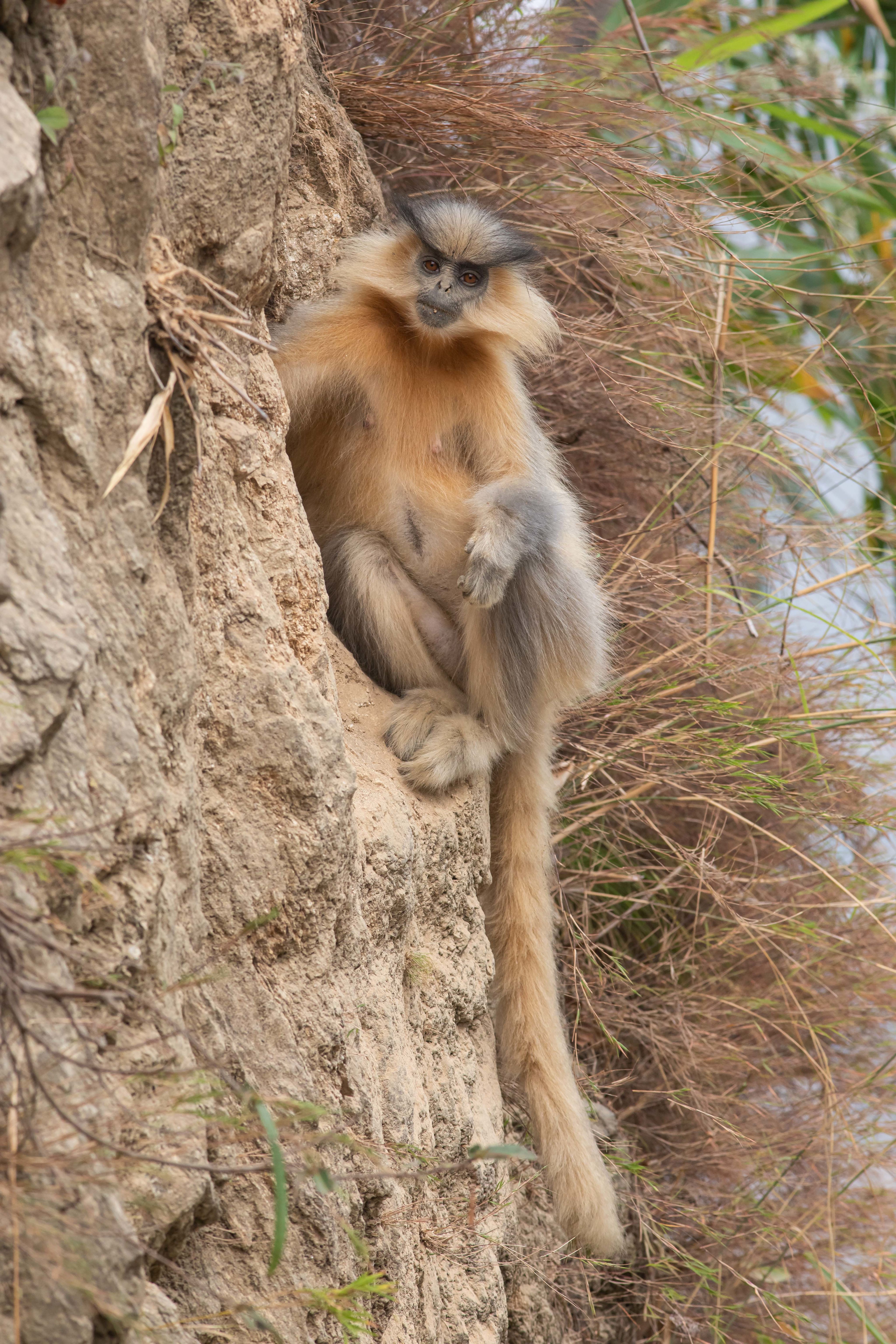
Wildlife around RMNP, Bhutan, includes the Golden Langur. Photo: Joshua F. Goldberg/BES
Through UNDP, in collaboration with the GEF SGP team, grants like this one in Bhutan serve as an example of the initiative's action on the ground.
Reaching the Next Tiger Summit Together
The 1st of February 2022 marks the beginning of the Year of the Tiger. In September, tiger range countries will convene at the second Global Tiger Summit in Vladivostok to assess progress towards the ambitious TX2 goal - to double the number of tigers in the wild - and to identify tiger conservation priorities for the next 12 years.
This year’s summit will build on commitments made at the first Tiger Summit a dozen years ago, which demonstrate that it is possible to establish a true human-tiger landscape where human/wildlife populations can coexist and also shows what can be achieved through long term commitments to tiger conservation.
Since 2010, UNDP has supported the majority of the tiger range countries through a range of interventions, primarily through projects financed by the Global Environment Facility and other multilateral and bilateral funds. UNDP, GEF, and numerous other international organizations have also joined and supported the governments’ commitment.
UNDP will continue to provide technical support through our collaborations with governments and partners in tiger range countries, including the GEF Small Grants Programme.
As such, the 2022 Year of the Tiger marks a key milestone anniversary - an occasion to celebrate and assess the progress that has been made and rededicate our efforts in service of tiger conservation globally.
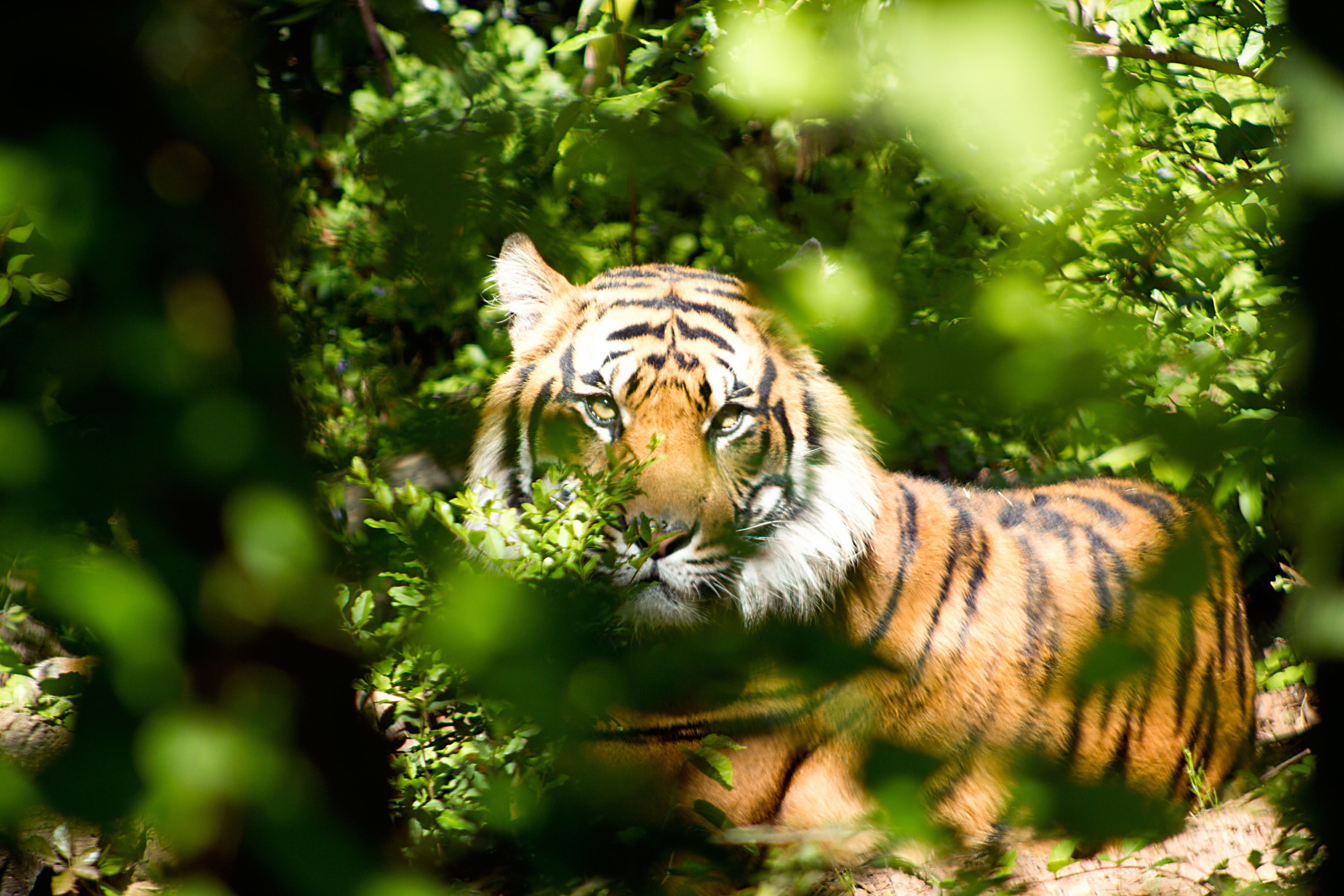
Local action = global impact
As a corporate programme of the Global Environment Facility, SGP has been implemented by UNDP since 1992, providing financial and technical support to civil society and community-driven initiatives that address global environmental issues while improving local livelihoods.
Since 1999, SGP has supported 183 projects in Bhutan in the areas of biodiversity, land degradation, climate change, chemicals and waste, and international waters.
For more details on SGP’s work in Bhutan, visit SGP’s Bhutan country page.
For information on SGP’s global portfolio, visit theglobal SGP website.

Story by: Story by: Pem Lama and Joshua F. Goldberg (BES), Andrea Egan, Ana Paula Canestrelli, Rissa Edoo, with input and support from The Lion's Share team and SGP Bhutan team.
Visual layout: Andrea Egan
Photos: © Joshua F. Goldberg/BES, and others as noted.
Header photo: © Chiru Clicks/Pexels.com
Location: Panbang, Bhutan

